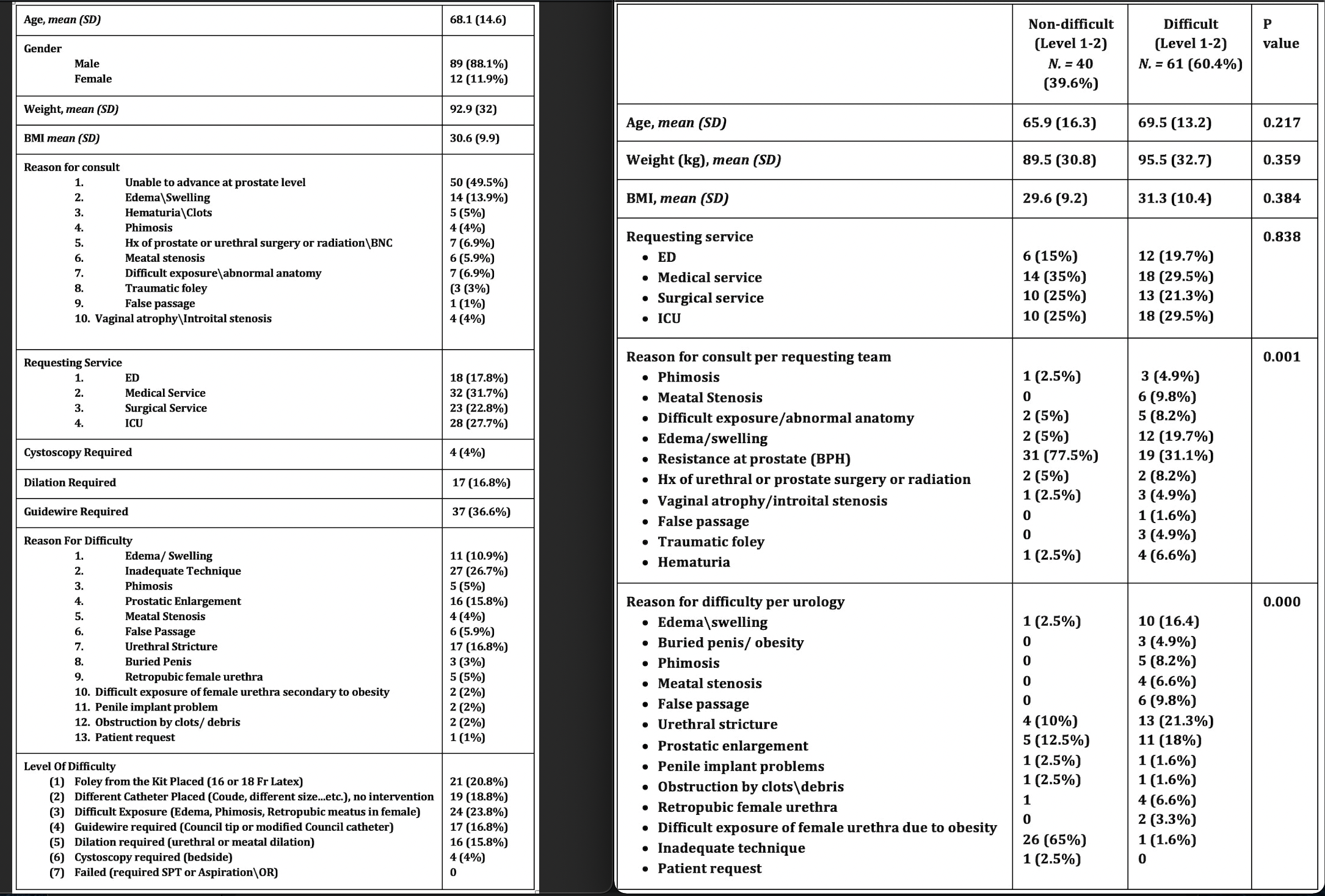Back
Poster, Podium & Video Sessions
Moderated Poster
MP41: Surgical Technology & Simulation: Training & Skills Assessment
MP41-18: Difficult Foley? A Look Into Difficult Foley Consults
Sunday, May 15, 2022
10:30 AM – 11:45 AM
Location: Room 228
Katharina Mitchell*, Amr Elbakry, Caitlyn Patton, John Barnard, Morgantown, WV, Chad Morley, Morgantown , WV

Katharina Marie Elisabeth Mitchell, MD, BS
West Virginia University
Poster Presenter(s)
Introduction: While urethral catheters are usually placed without issue, many factors can make placement challenging. Here we aim to further understand reasons for difficulty and the role of urology consultation.
Methods: This is a prospective study that was conducted at a tertiary care hospital from April 2018 through March 2020. We prospectively collected data on multiple parameters including patient demographics, reason for consultation determined by consulting service, consulting service, whether the patient was ICU status, and the level of, and reason for difficulty determined by the urology team. Patients were divided into two groups according to level of difficulty.
Results: Most consultations were male patients (88.1%). The most common reason for consultation per consulting team was inability to advance at a level of the prostate (49.5%). Advanced interventions for foley placement which were investigated included guidewire, dilation, and cystoscopy- of these the most commonly utilized was guidewire (36.6% of cases). The most common reason for difficult placement, as determined by the urologist, was inadequate technique (26.7%). The level of difficulty was determined by set criteria of interventions employed by the urologist- the most commonly ascribed was level 3 (23.8%). Most common reason for consultation in the non-difficult group was resistance at the prostate, while the most common reason for difficulty was inadequate technique. When comparing foleys placed in the difficult and non-difficult classifications- it was seen using Chi-Squared statistical analysis that there was not a statistically significant difference among the groups when comparing variables such as age, gender, weight, BMI. However, there was a statistically significant difference between the groups when examining the reason for consults and reason for difficulty determined by urologist, 0.001 and 0.000 respectively.
Conclusions: Our study provides an understanding of reasons for consultations regarding foley placement and different levels and reasons for difficulty, which can help optimize and improve the process of foley placement in the hospital setting.
Source of Funding: None

Methods: This is a prospective study that was conducted at a tertiary care hospital from April 2018 through March 2020. We prospectively collected data on multiple parameters including patient demographics, reason for consultation determined by consulting service, consulting service, whether the patient was ICU status, and the level of, and reason for difficulty determined by the urology team. Patients were divided into two groups according to level of difficulty.
Results: Most consultations were male patients (88.1%). The most common reason for consultation per consulting team was inability to advance at a level of the prostate (49.5%). Advanced interventions for foley placement which were investigated included guidewire, dilation, and cystoscopy- of these the most commonly utilized was guidewire (36.6% of cases). The most common reason for difficult placement, as determined by the urologist, was inadequate technique (26.7%). The level of difficulty was determined by set criteria of interventions employed by the urologist- the most commonly ascribed was level 3 (23.8%). Most common reason for consultation in the non-difficult group was resistance at the prostate, while the most common reason for difficulty was inadequate technique. When comparing foleys placed in the difficult and non-difficult classifications- it was seen using Chi-Squared statistical analysis that there was not a statistically significant difference among the groups when comparing variables such as age, gender, weight, BMI. However, there was a statistically significant difference between the groups when examining the reason for consults and reason for difficulty determined by urologist, 0.001 and 0.000 respectively.
Conclusions: Our study provides an understanding of reasons for consultations regarding foley placement and different levels and reasons for difficulty, which can help optimize and improve the process of foley placement in the hospital setting.
Source of Funding: None


.jpg)
.jpg)